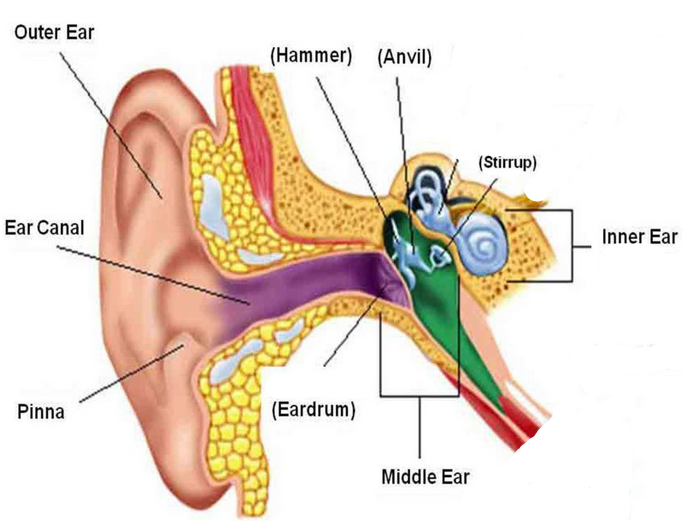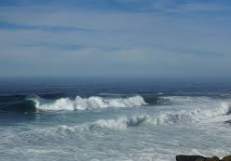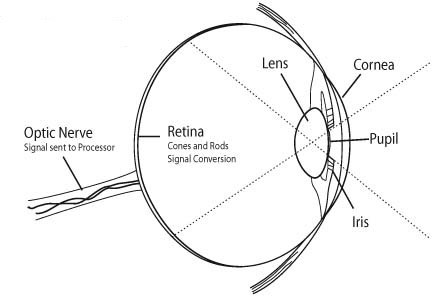Ed's
AV Handbook
Batting Practice for the AV Professional
and primer for the novice
Chapter
2 Page 4
AV Physics
Did you hear that?
When waves crash on a beach,
they transmit acoustical-energy in a spring-like motion
through the air that arrives in the ear as sound. The
crashing waves cause air molecules to compress and
then rarefact into neighboring molecules.
This cycle continues until the sound waves terminate
in the ear or fade away.

In route to the brain, the ear converts compression and rarefaction of air molecules into neuron discharges. The compressions/rarefactions enter the pinna, the ear's directional encoder. They then proceed into the auditory canal, the ear's resonating acoustic amplifier. At the exit of the auditory canal, the resonations beat on its membrane-acoustic barrier, the eardrum.
The resonating 'drum' mechanically links with the bone structure of the hammer, anvil, and stirrup of the middle ear's next boundary, the oval window of the inner ear. All of this mechanical action activates the fluid sack of the inner ear, the final chamber.
The Ear

In route to the brain, the ear converts compression and rarefaction of air molecules into neuron discharges. The compressions/rarefactions enter the pinna, the ear's directional encoder. They then proceed into the auditory canal, the ear's resonating acoustic amplifier. At the exit of the auditory canal, the resonations beat on its membrane-acoustic barrier, the eardrum.
The resonating 'drum' mechanically links with the bone structure of the hammer, anvil, and stirrup of the middle ear's next boundary, the oval window of the inner ear. All of this mechanical action activates the fluid sack of the inner ear, the final chamber.
The compression and
rarefactions of the inner ear fluid stimulate hair-like
nerve terminals in the inner ear. The shifting
hair-like nerves of the inner ear generate neuron discharges
that finally convey signals to the brain that produce sound.
See the waves crash on the beach.
 Light
transmits energy in a spring-like motion via a sea of
electromagnetic energy into our eyes. For example, the
sun creates electromagnetic energy that compresses and
rarefacts until the energy encounter a surface such
as crashing waves.
Light
transmits energy in a spring-like motion via a sea of
electromagnetic energy into our eyes. For example, the
sun creates electromagnetic energy that compresses and
rarefacts until the energy encounter a surface such
as crashing waves.A surface, like water, absorbs much of the energy. The remainder reflects off the surface. The reflected energy initiates another compression/rarefaction cycle that continues until it terminates in our eyes as a visible wave on the beach.
The Eye
The eye converts electromagnetic light into neuron discharges. Light enters the window of the eye -- the cornea and pupil. The light then encounters the focusing lens of the eye. It directs the light to the energy transfer point of the eye, the retina. The retina consist of light-sensitive antennas called cones and rods. The cones and rods stimulate the optic nerve that produced neuron discharges to the brain.
Review of the wave:
FrequencyCycles per Second = Hertz = Hz
Frequency describes ...
the timber of sound,
the color of light,
a radio broadcast frequency.
Wavelength
Wavelength =
Speed ÷ Frequency,
the distance traveled by one cycle of the wave.
Sound ranges from 56.5 ft. to 0.0565 in.
Light ranges from 440 nm to 700 nm
Radio ranges from a fraction of an inch to several hundred yards
Amplitude
Amplitude of the wave = power
Volume in decibels.
Brightness in lumens
Radio power in watts.
Subjective Intensity
Subjective power of the wave =
Loudness of sound,
Luminance of light.
the distance traveled by one cycle of the wave.
Sound ranges from 56.5 ft. to 0.0565 in.
Light ranges from 440 nm to 700 nm
Radio ranges from a fraction of an inch to several hundred yards
Amplitude
Amplitude of the wave = power
Volume in decibels.
Brightness in lumens
Radio power in watts.
Subjective Intensity
Subjective power of the wave =
Loudness of sound,
Luminance of light.
Ed's AV
Handbook
Copyright 2007 Txu1-598-288 Revised 2024
Copyright 2007 Txu1-598-288 Revised 2024
Sponsored
By
Architectural
Speaker Tuning System
for
in-wall/ceiling custom installed speakers.
Reclaim the performance you paid for.
Site Menu
Home
Table of
Contents
Handbook Chapters
1 AV
Terms
2 AV Physics
3 Sound Reproduction
4 Video Reproduction
5 The AV System Sequence
6 The Room, Speaker, & TV
7 Acoustical Strategy - Small Room
8 Home Theater by Design
9 AV Sales Training
10 AV Business & Marketing
Contact
About

